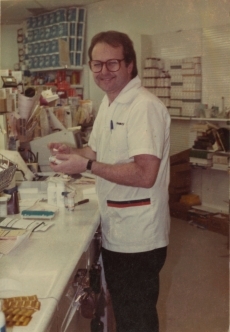Over the past two years, I have had the pleasure of meeting with over 100 immigrants from South Africa and Zimbabwe as part of the OJA’s Southern African Legacy Project [read more about SALP here]. The people I have met have lived fascinating and varied lives in Canada – from one man who started a museum on the history of contraception, to another who is a doctor and travelled the world on medical missions, to a prominent female entrepreneur who invented her own line of mirrors. With each shared photograph, document, and story, the larger history and legacy of this immigrant community as leaders, philanthropists and community builders begins to emerge. The records also reveal the community’s unique sense of humour, friendliness and warmth.
I am so grateful to all the people who have welcomed me into their homes or taken the time to visit me at the archives. It has been a fascinating experience and I have learned so much along the way. As we approach the final phase of this project, I thought it would be fitting to share some of the interesting facts I have learned alongside my own personal observations:
-
The earliest Jewish South African immigrant to Ontario I have learned about is Eli Bloch. He arrived in Toronto in 1907 while working as a travelling salesman selling ostrich feathers (a fashion trend at the time). He met his future wife here and stayed.
-
When leaving South Africa in the later half of the 1900s, there was a restriction on how much money emigrants could take with them out of the country. As a result, many brought non-perishable items with them or other valuable items, such as rugs and jewelry, which they could sell in Canada.
-
Canada often wasn’t the first or only place immigrants considered (many considered Israel, the USA or Australia). The decision to move to Canada was carefully planned and thought through. Some even travelled to various destinations before choosing where to go (called a “look-see” trip).
-
Most of the people I have met have immediate family members spread out in various parts of the world – mostly in Australia, Israel, England, and South Africa.
- All the people I met had maids and/or gardeners in South Africa. When they arrived in Canada many South Africans had to adjust to the new lifestyle without this help. One woman explained to me that she has still never cooked herself a meal (she arrived in early 1980s when she was in her 60s)
- All the South Africans I have spoken to have impressed upon me how violent it was there. For instance, one woman from Zimbabwe explained that when they went on road trips, they always drove in large caravans with armoured vehicles. Nearly all tell me how lucky I am to live in Canada.
- Everyone I met who immigrated to Canada after the 1950s left South Africa due to its Apartheid politics and/or the worsening violence in the country. Most people described how they did not want to raise their children in that environment and saw no future for them there.
- Most of the people I have met went to a Jewish Day School in South Africa. Their positive experiences led many of them to send their children to Jewish Day Schools in Canada.
- Many of the people I have met have been incredibly successful in their lives in Canada. Many became leaders in their fields, worked hard to grow successful businesses and build a new life in Canada, and are committed to volunteer and philanthropic activities.
- Everyone I have met is proud to live in Canada. Most people tell me it is the best place in the world to live.
The project has been a tremendous success, with dozens of recorded oral history interviews and thousands of collected photographs and documents for the archives collection. In fall 2017, we will be launching a dynamic online exhibition showcasing these incredible stories. I encourage anyone who would like to participate to contact me at mcaza@ujafed.org or 416-635-5391 x. 5110.
Melissa Caza
Archivist, Ontario Jewish Archives
![Eli Bloch in South Africa during the Boer War, [1900?]. OJA, accession #2016-7/9.](https://ontariojewisharchives.org/cms_uploads/images/quotes/2016-7-8_005.jpg)
